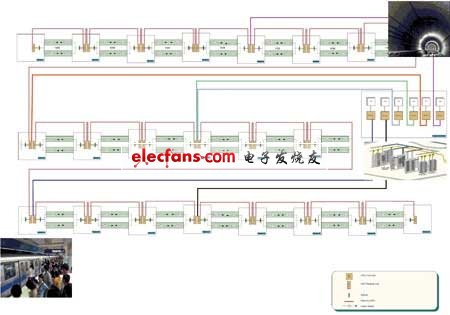At present, the wireless signal coverage methods used by subways are basically constructed by multiple operators using POI high-power signal sources and coaxial feeders. At present, various communication requirements are increasing day by day. Various mobile phone communication, wireless intercom, wireless Internet access and other functions require the construction of multiple independent systems, resulting in strained computer room resources, construction difficulties, complicated management and maintenance, and new functions. Need to be redesigned and planned.
URH is a new-generation wireless solution proposed by ADC in order to improve wireless capacity, coverage and flexibility to meet customer needs. The wireless computer room divides the wireless signal to improve the wireless capacity and distribution range, and the downstream signal is adaptively adjusted to compensate for the attenuation of the signal. It is an intelligent signal coverage system (as shown in Figure 1).

Figure 1 URH intelligent signal coverage system
URH uses optical fiber transmission technology to distribute radio frequency signals to areas where it is needed. URH digitizes all specified radio frequency bands, transmits them in dark mode through dark fiber or millimeter wave (MMW) links, and can reconstruct the signal in the entire bandwidth regardless of the modulation technology used at the far end. The digital radio frequency transmission of the ADC allows radio frequency signals not to be affected by the link length, but is replicated in all dynamic bandwidth ranges to improve data throughput. Because service providers also have to deal with 3G to 4G upgrades, high-data-rate broadband services, and networks using URH high-speed links have already prepared service providers for upgrades.
URH Solution Overall Design Ideas URH remote unit modules are placed at each station and no machine room is required.
The partition design of the sector divides the station into fewer partitions and reduces switching.
Support multiple carriers and multiple carriers, support later upgrade 3G / 4G.
Only one central computer room is needed, and the base stations are placed centrally.
Realized by the loop function equipment of the system itself, with automatic switching function. A loop is formed between the URH master end of each cell and the 8 URH far ends in sequence, and a fault is automatically switched.
Technical characteristics of URH solution The system uses all-digital optical fiber distribution technology, long-distance transmission without noise.
Multiple systems are transmitted via digital optical fiber.
A single computer room with multiple lines.
A single system supports multi-network integration of multiple communication systems in the 800MHz, 900MHz, and 2100Hz frequency bands (as shown in Figure 2).

Figure 2 Schematic diagram of the URH scheme
Comparison between URH solution and POI solution
Equipment investment comparison
In terms of the number of equipment rooms, there is one POI plan for each station, and multiple stations in the URH plan share one. The number of equipment rooms and supporting air-conditioning and other facilities require a group for each station in the POI solution. The URH solution can be satisfied only by a group of centralized equipment rooms. In terms of base station sources, the URH solution does not require power base station source equipment, only low-power or pico-power base station sources, which can save a lot of resources in terms of sources.
Due to the centralized placement of base stations, there is no need to design a base station at each station, so transmission equipment can be saved by 100%.
Comparison of distributed system performance
The POI scheme uses analog RF power boosting technology, while the URH scheme uses optical fiber digital distribution technology. The former networking method requires a switch when the train passes each station, which is easy to drop calls and reduce the capacity of the base station. The latter adopts There is no switching between 4-5 stations in the large area system, which ensures the dynamic allocation and scheduling of the system capacity. In addition, the noise figure of the digital distribution system is much smaller than that of analog RF equipment. In CDMA-based mobile communications, the system capacity is equivalently increased, the transmission power of the mobile phone is reduced, and the battery life of the mobile phone is extended. In the later optimization process, it is difficult to plan and allocate capacity by POI by cell, and the centralized placement of URH base stations can flexibly implement carrier scheduling through the central computer room. And can realize the daisy chain and self-healing loop function through the optical path, which increases the system reliability.
Construction comparison
The POI has a large volume and large power consumption, and it needs to be amplified separately from the upstream and downstream. If the power at the end is not enough, it needs to be split and amplified by a separate system. The URH scheme has 19 storage racks at the front end and 3U high. The construction is simple and convenient.
Therefore, in the context of large-scale construction of domestic urban rail transit, the URH solution is a high-quality energy-saving and environmentally friendly solution that is easy to upgrade and maintain later, that is, saving supporting resources, saving energy consumption, and improving network service quality.
Neon Led Strip,Purple Neon Lights,Neon Light Signs Custom,Neon Lights For Bedroom
Tes Lighting Co,.Ltd. , https://www.neonflexlight.com